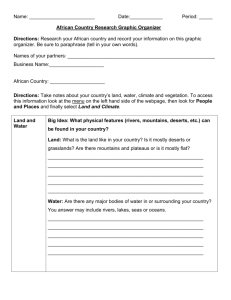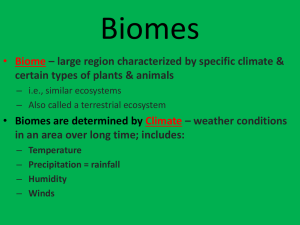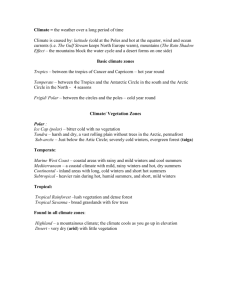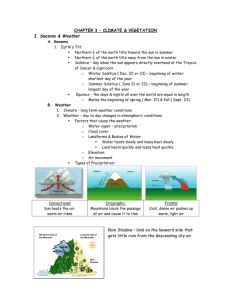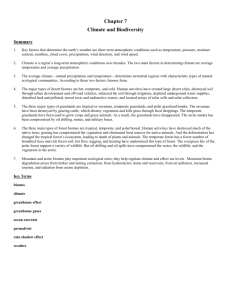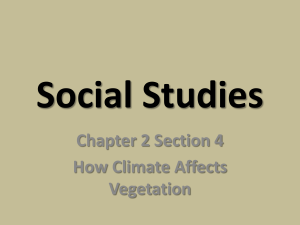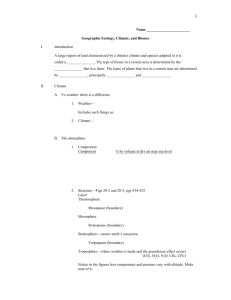Chapter5 - mariaoconnell
advertisement
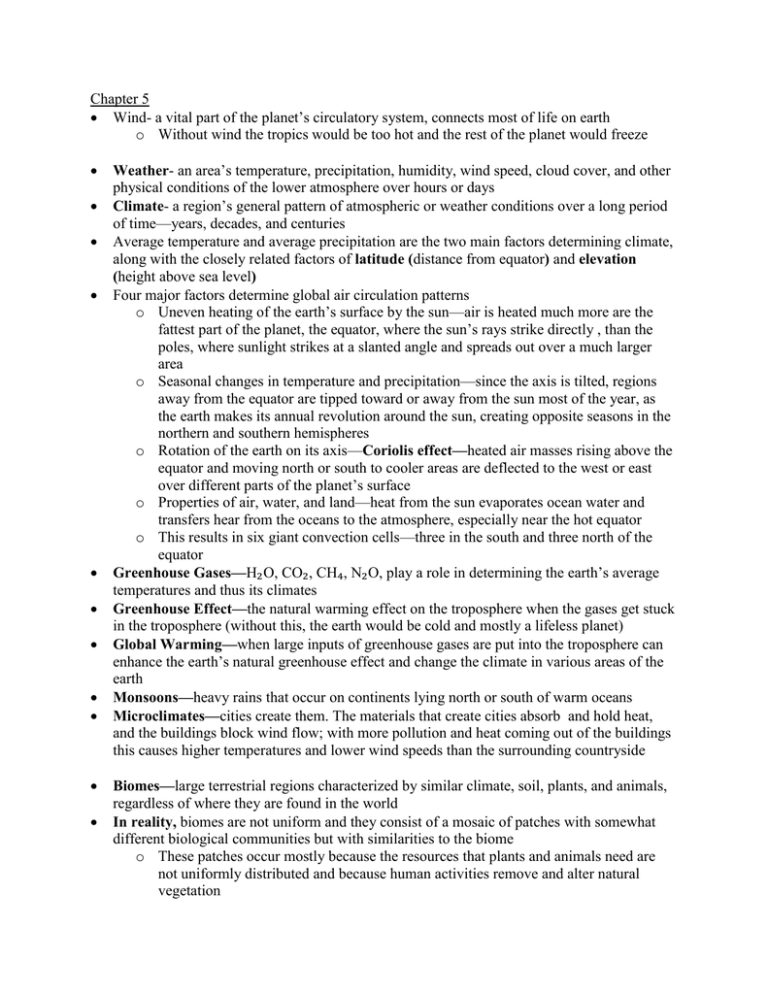
Chapter 5 Wind- a vital part of the planet’s circulatory system, connects most of life on earth o Without wind the tropics would be too hot and the rest of the planet would freeze Weather- an area’s temperature, precipitation, humidity, wind speed, cloud cover, and other physical conditions of the lower atmosphere over hours or days Climate- a region’s general pattern of atmospheric or weather conditions over a long period of time—years, decades, and centuries Average temperature and average precipitation are the two main factors determining climate, along with the closely related factors of latitude (distance from equator) and elevation (height above sea level) Four major factors determine global air circulation patterns o Uneven heating of the earth’s surface by the sun—air is heated much more are the fattest part of the planet, the equator, where the sun’s rays strike directly , than the poles, where sunlight strikes at a slanted angle and spreads out over a much larger area o Seasonal changes in temperature and precipitation—since the axis is tilted, regions away from the equator are tipped toward or away from the sun most of the year, as the earth makes its annual revolution around the sun, creating opposite seasons in the northern and southern hemispheres o Rotation of the earth on its axis—Coriolis effect—heated air masses rising above the equator and moving north or south to cooler areas are deflected to the west or east over different parts of the planet’s surface o Properties of air, water, and land—heat from the sun evaporates ocean water and transfers hear from the oceans to the atmosphere, especially near the hot equator o This results in six giant convection cells—three in the south and three north of the equator Greenhouse Gases—H₂O, CO₂, CH₄, N₂O, play a role in determining the earth’s average temperatures and thus its climates Greenhouse Effect—the natural warming effect on the troposphere when the gases get stuck in the troposphere (without this, the earth would be cold and mostly a lifeless planet) Global Warming—when large inputs of greenhouse gases are put into the troposphere can enhance the earth’s natural greenhouse effect and change the climate in various areas of the earth Monsoons—heavy rains that occur on continents lying north or south of warm oceans Microclimates—cities create them. The materials that create cities absorb and hold heat, and the buildings block wind flow; with more pollution and heat coming out of the buildings this causes higher temperatures and lower wind speeds than the surrounding countryside Biomes—large terrestrial regions characterized by similar climate, soil, plants, and animals, regardless of where they are found in the world In reality, biomes are not uniform and they consist of a mosaic of patches with somewhat different biological communities but with similarities to the biome o These patches occur mostly because the resources that plants and animals need are not uniformly distributed and because human activities remove and alter natural vegetation Climate and vegetation vary with latitude and elevation Desert Biomes An area where evaporation exceeds precipitation o Precipitation is low in these driest of the earth’s biomes and is often scattered unevenly throughout the year Covers about 30% of the earth o Mostly found in tropical and subtropical regions o Largest desserts are found in the interiors of continents, away from the moist sear air and moisture-bearing winds o More local deserts can form on the downwind sides of mountain ranges because of the rain shadow effect The heat from the sun is absorbed during the day and then released at night o Resulting in freezing nights Soils have little vegetation and moisture to help store the heat and the skies above are usually clear Tropical deserts o Hot and dry most of the year o Few plants and a hard, windblown surface strewn with rocks and some sand Temperate deserts o Daytime temperatures are high in summer and low in winter o More precipitation than in tropical deserts o Sparse vegetation consists mostly widely dispersed drought-resistant shrubs and cacti or other succulents adapted to the lack of water and temperature variations Cold deserts o Vegetation is sparse o Winters are cold, summers are warm or hot and precipitation low How plants and animals survive? o Beat the heat and every drop of water counts o To survive plants drop their leaves to stay in a dormant state o Succulent plants have three adaptations: Have no leaves Store water and synthesize food in their expandable fleshy tissue Reduce water loss by opening their pores (stomata) to take up carbon dioxide only at night o Spines of many plants are a protection against herbivores that want the water o Some plants use deep roots to tap into groundwater o Evergreen plants conserve water by having waxy coated leaves that reduce water loss o Wildflowers and grasses store much of their biomass in seed that remain inactive, sometimes for years, until the receive enough water to germinate o Most desert animals are small Beat the heat by hiding in cool burrows or rocky crevices by day and coming out at night or in the early morning Others become dormant during periods of extreme heat or drought Insects and reptiles have thick out coverings to minimize water loss through evaporation, and their wastes are dry feces Extremely fragile o Soils take a long time to recover from disturbances because of their slow plant growth, low species diversity, slow nutrient cycling, and lack of water o Desert vegetation destroyed by livestock over grazing and off-road vehicles Grasslands and Chaparral Biomes Or prairies, occur mostly in the interiors of continents in areas too moist for deserts and too dry for forests Persist because of a combination of seasonal drought, grazing by large herbivores, and occasional fires o All of these keep large numbers of shrubs and trees from growing Three types: tropical, temperate, and polar (tundra) o Result from combinations of low average precipitation and various average temperature Tropical Grasslands: Savannas o Savannas are tropical grasslands with scattered trees and enormous herds of hoofed animals o Is a type of tropical grassland dotted with widely scattered clumps of trees o Usually has warm temperatures year-round and alternating dry and wet seasons o Drought during the dry season, and occasional fires started by lightning during the beginning of the wet season, and intense grazing inhibit growth of trees and bushes o Birthplace of mankind o Stretches across parts of Africa, Australia, India, South America, and other dry tropical regions o Animals that are farsighted, swift, and stealthy have the best chance of surviving Grazers—grass and herb eating Browsers—twigs and leaf nibbling These two apply to wildebeests, gazelles, zebras, giraffes, and antelopes Their predators are lions, hyenas and humans Large grazing animals migrate to find food and water in response to seasonal and year-to-year variations in rainfall and food availability Most grazing animals migrate to widely spaces water holes during the two rainy seasons As a part of their niches, they have evolved specialized eating habits that minimize competition between species for vegetation o Plants are adapted to survive drought and extreme hot or cold Many have deep roots that can tap into groundwater o Cattle are over grazing causing the grassland to turn into a desert Temperate Grasslands: Fertile Soil o Covered vast expenses of plaints and gently rolling hills in the interiors of North and South America, Europe and Asia o Winters are bitterly cold and summers are hot and dry o Annual precipitation is fairly sparse and falls unevenly through the year o Drought, occasional fires, and intense grazing inhibit growth of trees and bushes, except along rivers and streams o Because most of the grasses die and decompose each year, organic matter accumulates to produce a deep, fertile soil o Soil is held in place by a thick network of intertwined roots of drought-tolerant grasses o Natural grasses are also adapted to fires ignited by lightning or set deliberately The fires burn the plants above ground but do not harm the roots below, from which new life can spring up o Include short-grass prairies and tall-grass prairies Wind blows all the time and evaporation is rapid, often leading to fires in the summer and fall The winds and fire help maintain the grasslands o Their fertile soils has been used to grow crops, raise cattle, and build towns and cities Polar Grasslands: Arctic Tundra o Lie south of the arctic polar ice cap o Most of the year, these treeless plants are bitterly cold, swept by frigid winds, and covered with ice and snow o Winters are long and dark o The scant precipitation falls as snow o Under the snow is a spongy mat of low growing plants, primarily grasses, mosses, lichens and dwarf shrubs o Most plant growth is during the 6 to 8 week summer where the sun shines most of the time o Permafrost—underground soil water stays frozen for more than 2 consecutive years During the brief summer it prevents snow from melting and ice from soaking into the ground Consequence—the waterlogged tundra forms large numbers of shallow lakes Flies and other insects thrive in these pools o During the long and cold winters the surface soil also freezes o Animals in this biome survive the intense winter cold through adaptations such as thick coats of fur (arctic wolf/fox, and musk oxen), feathers (snowy owl), and living underground o Fragile biome because its short growing season means its soil and vegetation recover very slowly from damage and disturbance o Human activities—oil drillings, pipelines, mines and military bases (leave scars that persist for centuries) o Alpine tundra—occurs above the limit of tree growth but below the permanent snow line on high mountains Vegetation is similar to that found in arctic tundra, but gets more sunlight and has no permafrost layer During the summer it can be covered by wildflowers Temperate Shrublands: Chaparral o Has moderate climate but is dense thickets of spiny shrubs are subject to periodic fires o Moderate, sunny climate with mild, wet winters and warm, dry summers o Closeness to the sea provides a slightly longer winter rainy season that nearby temperate deserts have, and fogs during the spring and fall reduce evaporation o Found along coastal areas of southern California in the US, The Mediterranean Sea, central Chile, southern Australia and southwestern South Africa o Consists mostly of dense growths of low-growing evergreen shrubs and occasional small trees with leathery leaves that reduce evaporation o Soil is thin and not very fertile o Animals include mule, deer, chipmunks, jackrabbits, lizards, and a variety of birds o During the summer the vegetation becomes very dry and highly flammable Fires start by lightning or human activities spread with incredible swiftness o Fire-resistant roots and have seeds that only sprout after a hot fire o Humans have moved in and modified it considerably o Nice climate, risky place to live Forest Biomes Found in tropical, temperate, and polar regions Forests have enough precipitation to support stands of trees and are found in tropical, temperate, and polar regions Tropical Rainforest o Are found near the equator, where hot, moisture-laden air rises and dumps its moisture o Year-round have uniformly warm temperatures, high humidity, and heavy rainfall almost daily o Extremely diverse ecosystem o Dominated by a lush variety of broadleaf evergreen plants, which keep most of their leaves year-round o No specific tree dominates the forest o Typically has huge trees with shallow roots and wide bases that support their massive weight o The tops of the trees for a dense canopy which block most light from reaching the forest floor, illuminating it with him greenish light o Ground level has little vegetation, except near stream banks or where a fallen tree has opened up the canopy and let in sunlight Most of these plants have enormous leaves to capture the little light that comes in o Vines connect the trees near the top of the canopy o The species in this biome occupy a variety of specialized niches o Very little wind to spread seeds and pollen o Very little plant litter on the ground because there are hordes of decomposers o The soil tends to be acidic and low in nutrients Not a good place to grow crops o Destruction—used for logging, growing crops, grazing cattle and mineral extraction At least 40% of the forest has been destroyed The destruction of these forest are not stopping and it’s getting worse and might soon be gone o Tropical dry forests Found in tropical areas with warm temperatures year round and wet and dry season Tree heights are lower and tree canopies are less dense than in tropical rainforest Mostly has been cleared for growing crops and grazing livestock When cleared soils are subject to severe erosion during the extremely heavy rainy season Temperate Deciduous Forests o Most of the trees in these forests survive winter by dropping their leaves, which decay and produce a nutrient-rich soil o Grow in areas with moderate average temperatures that change significantly with the season o Have long warm summers, cold but not too severe winters and abundant precipitation, often spread fairly evenly throughout the year o Have fewer tree species that tropical rainforest, but the penetration of more sunlight supports a richer diversity of plant life at ground level o Dominated by a few species of broadleaf deciduous trees (such as oak, hickory, maple, poplar, and beech0 They survive cold winters by dropping their leaves in the fall and becoming dormant Each spring they grow new leaves that change in the fall into reds and golds o Because of the slow rate of decomposition, the forests accumulate a thick layer of slowly decaying leaf litter that is the storehouse of nutrients o Most of the predators have been displaced or killed—the main predator now is the white tailed deer o Small mammals include squirrels, rabbits, opossums, raccoons, and mice o Once covered half of the US and western Europe, but now these areas were settled, industrialized, and urbanized o Most disturbed terrestrial biome Evergreen Coniferous Forest o Consist mostly of cone-bearing evergreen trees that keep their needles year-round to help the trees survive long and cold winters o Also called taigas of boreal forests o Found just south of the arctic tundra o Winter are long, dry, and extremely cold, sunlight is available only 6-8 hours a day o Summers are short, with cool to warm temperatures and sun shines up to 19 hours a day o Dominated by a few coniferous evergreen trees (spruce, fir, cedar, hemlock, and pine) keep their needles all year long Waxy coats allow them to withstand the harsh winters and drought of winter when snow blankets the ground o Plant diversity is very low because few species can survive the winters when soil moisture is frozen o Decomposition is slow because of the low temperatures, waxy coating of coniferous needles, and high soil acidity o Since the soil is acidic it prevents most other plants from growing on the forest floor o Animals year-round include bears, wolves, moose, lynx, and many burrowing rodents o In the summer the soil gets waterlogged and many insects come to feed off of it Temperate Rain Forests o Found in scattered coastal temperate areas with ample rainfall or moisture from dense ocean fogs o The ocean moderates the temperature so the winters are mild and the summers are cool o Most of the trees are evergreen o Little light reaches the forest floor Mountain Biomes Are high-elevation forested islands of biodiversity and often have snow-covered peaks that reflect solar radiation and gradually release water to lower-elevation streams and ecosystems Cover about one-fourth of the earth’s land surface Places where dramatic changes in altitude, climate, soil and vegetation take place over a very short distance Because of steep slopes, soils are especially prone to erosion when the vegetation holding them in place is removed by natural disturbances or human activities Are often habitats for endemic species (species found nowhere else) Serve as sanctuaries for animal species driven from lowland areas Help regulate climate Mountaintops with snow or ice reflect solar radiation back into space Gradually release melting ice, snow, and water stored in souls and vegetation or mountainsides to small streams Are coming under increasing pressure from several human activities Human impacts on Terrestrial Biomes We use, waste, and destroy about 10-55% of the net primary productivity of the earth’s terrestrial ecosystems About 60% of the world’s major terrestrial ecosystems are being degraded or used unsustainably

